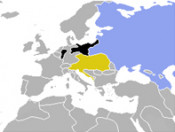
“Holy Alliance” was signed
On 14 (26) September 1815 the Emperor of Russia Alexander I, the Emperor of Austria Franz I and the King of Prussia Friedrich Wilhelm III met in Paris to sign the “Act of Holy Alliance”.
The Act of Holy Alliance’s creation was affected by the religious ideas and contained references to the teaching of Jesus Christ, which “taught the men to consider each other as brethren, and not live in hostility and malice, but in peace and love”. The contracting Monarchs considered each other as fellow countrymen, and agreed, on all occasions and in all places, to lend each other aid and assistance…” In other words the Holy Alliance represented a kind of treaty, which was intended to provide mutual aid between the Monarchs of Russia, Austria and Prussia on a large scale. The principal aim of the Alliance was to guard the postwar borders of Europe and make every effort to prevent the revolutionary influence.
In November 1815 the Holy Alliance Act was signed by the King of France Louis XVIII. Except for the Prince Regent of Great Britain, the Sultan of the Ottoman Empire and the Pope of Rome, all other European nations joined. However the representatives of Great Britain always participated in the Alliance Congresses and had influence over their decisions. The Russian Emperor Alexander I (the Holy Alliance was created at his behest) and the Chancellor of Austria Klemens Wenzel von Metternich performed the principal role in the Holy Alliance’s activities.
The Holy Alliance organized four Congresses to work out the principle of intervention into the European countries’ home affairs. It was practiced when the Austrian troops invaded Italy in order to suppress the rebellion in Naples (1820–1821). The same way the rebellion in Spain was defeated by the French Army in 1820–1823. Relying on the main aims of the Holy Alliance its participants were against the liberation War of Greeks against the Turkish Yoke.
The Congress of Vienna in 1822 and the intervention into Spain were the last important acts carried out by the Holy Alliance, after that in fact it became defunct. In 1825–1826 the Greek issue strained the Russo-Austrian relations. Alexander I (in the end of his reign) and then Nicholas I offered assistance to the Greek, whereas Klemens Wenzel von Metternich continued his policy against the Greek rebels. The relations between the Holy Alliance and Great Britain also began to worsen, because Britain was interested in US colonies in Spain and recognized its independence. The contradictions between other members of the Holy Alliance also were intensified.
Despite the attempts of the European Monarchs the revolutionary and liberation rebellions continued to develop. In 1825 the Decembrist revolt took place in Russia, in 1830 France and Belgium were stricken by revolutions. In 1830–1831 the revolt against tsarism broke out in Poland. These events threatened not only the principles, but the very existence of the Holy Alliance. The contradictions between the members of the Alliance were so serious that they resulted into its breakup in the end of 20-s–beginning of 30-s XIX cent.
Lit.: История дипломатии. Т. 2. М., 1945. Гл. 6. От создания Священного Союза до Июльской революции (1815–1830 гг.); Троицкий Н. А. Россия в XIX веке. М., 1997. Из содерж.: Россия во главе Священного союза: Монархи против народов.
Based on the Presidential Library’s materials:
Полное собрание законов Российской империи, с 1649 года. СПб., 1830. Т. 33. № 25943.

